Overview:
After exploring the topic of holistic wellness, and the medicine wheel further I have decided my project will be a form of design; creating a grade 6 classroom in Chilliwack BC that supports holistic wellness. My approach will be a combination of classroom supports or routines that allow students to explore their own wellness, while supporting the wellness of the community. Ideally, this year-long study would incorporate storytelling, or oral knowledge from community members. This design-based project will allow students to have input and explore the areas of holistic wellness; becoming more in tune with their own minds, bodies and souls and how this affects those around them. Students will think critically and creatively in order to improve an area of wellness in their personal lives, their classroom, their family or the greater community. The unit or overarching ideas will lead to a design-thinking project, where students take one aspect of wellness, and create a plan to improve it (can be physical space, a routine, a personal goal, community program etc.) A large part of the unit/study will incorporate sharing, reflection and emphasis on the connection to ourselves and others. Instead of this being a complete unit of study, it is a guide on how to incorporate teachings and learning of wellness and weave it directly into our day-to-day curriculum with a sample project for the “end.” My hope would be that by keeping a wellness journal, the discussions about health and the exploration of holistic wellness would naturally come up within all disciplines. Although embedded in this framework is curriculum of language arts, and physical and health education, there will be natural connections and opportunities to engage in exploration, reflection and inquiry throughout the school year (ex: how are we feeling after gym class? After doing math? How do field trips, or recess/lunch impact our overall health?).
Topic Highlights, Resources and Research:
The real goal of this framework is to have students develop a sense of connectedness to themselves, to others and understand the complicated interwoven aspects of holistic health that they can carry forward in to life.
As Heeson Bai explains, this is the “other” type of learning that “prepares a person for the uncertain, ambiguous and unpredictable aspects of life” (p.45).
Storytelling and Picture Books:
“A critical prerequisite for meaningful, engaged learning is a strong sense of community and social wellness in the classroom” (Tinckler, 2017, p.319).
I would like to use picture books to compliment this inquiry project. Since an ongoing assessment and reflection project will occur throughout the duration of the year, I see story as a way to invite students into exploring holistic wellness. Rachel Tinckler, an elementary school teacher in Calgary, completed a study on the connection between storytelling and social wellness. She believes that “storytelling has tremendous power to form, strengthen, and maintain our sense of self, our perception of others, and our sense of community” (2017, p.319). Of course, storytelling can be used to enhance literacy skills, or just for the sake of reading a story. However, story is infused in the curriculum, and can be used as an invitation for any discipline. In fact the study of a discipline or new topic can become a story itself through inquiry based learning (Egan, 1986).
The “practice of storytelling fosters social wellness and cohesion in the classroom community and supports the healthy development of each child as a whole human being within that community” (Tinckler, 2017, p.320). The author of this study believes that a classroom is a community, and the health of the said community has a direct impact on each of its members.
Carlson and Arthur (1999) believe that every child is striving continually to become a well-adjusted human. Through storytelling, a child’s wellness is supported by: promoting her capacity for emotional processing and resilience, making personal meaning, and cultivating personal connections (Tinckler, 2017)
I think it can be daunting and controversial to discuss wellness in the classroom, as it is something that is so individual and up to interpretation. I see the use of stories, both from picture books, oral videos or stories from local elders to be an entry point for educators to discuss holistic wellness from an exploratory standpoint. Although there are millions of stories that would be an entry point for exploration, reflection or enjoyment, there are a few that I have selected to begin a running list (Any suggestions, send them my way!).
Sample Stories:
- Medicine Wheel Education Stories
(The Medicine Wheel, Stories of a Hoop Dancer will be used in sample lesson plan).
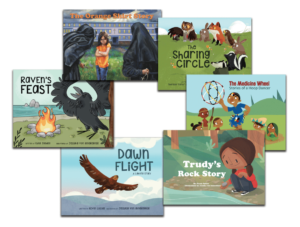
- Susan Verde, “I am” Series
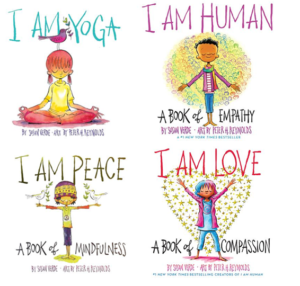
- SD33 Aboriginal Education Programs/Storytelling
SD33 provides a large selection of stories that support Aboriginal history and holistic wellness. They also have elders and other community members from local bands that come and share stories, activities, and spend time with classrooms (which I have experience first hand- drumming, singing, dancing, storytelling, art etc.). A list of resources and programs is located here: https://aboriginaled.sd33.bc.ca/node/23
More to come… 🙂
Holistic Wellness:
“We need all four directions (physical body, spirit, emotions, and mind) to create and find balance within the realms. Once we find this balance of self, we are whole” (Teaching Aboriginal Education Blog, 2018).
What is Wellness? The term wellness refers to general or overall good health, and a sense of well-being in one’s life (Schwartz, 2013). Upon further research of the medicine wheel, I am reminded of the importance of community health along with individual health. The Medicine Wheel is a “representation of all things connected within the circle of one’s life” (Teaching Aboriginal Education Blog, 2018). The centre of the medicine wheel is where the teachings come from, and represents ourselves in the moment working on ourselves from the inside out. The medicine wheel is related to Maslow’s Hierarchy of Needs. Both the medicine wheel and Maslow’s Hierarchy recognize he same four key areas of needs- physical, mental, emotional, and spiritual well-being (Aboriginal Education Blog, 2018). They also both recognize that without basic needs being met, students cannot reach their full potential. However, Maslow puts the needs and wellness of the individual before that of the community, which is not the same as the Aboriginal teachings of the medicine wheel.
Maslow’s theory “suggests that humans are motivated to fulfill first the most basic of needs, such as food, clothing and shelter. Once those needs are met, they move on to the need for safety and security. The needs become progressive, advancing to love and intimacy and then self-esteem before reaching self-actualization. The highest level is where humans are self-aware and grow to achieve their individual potential” (Michel, K., 2014). However, Maslow visited the Blackfoot nation in Alberta in 1938. His ideas were influenced by these people, but there are some discrepancies in beliefs. Firstly, the hierarchy is not a triangle, it is a tipi, and it is believed that tipis can reach to the sky (Bray, 2019). A major difference between the beliefs of the Blackfoot people and Maslow, is the idea of self-actualization. In Maslow’s Hierarchy of Needs, self-actualization is at the top of the triangle, seen as fulfillment of an individual. However, the Blackfoot people believed that self-actualization belongs at the bottom of the tipi, and is the foundation of a community. The top of the tipi is called “cultural perpetuity”, which is often called the “breath of life” (Bray, 2019). See below a relational worldview model, created by Terry Cross (1997;2007) based on the breath of life theory share by Blackstock in 2011.
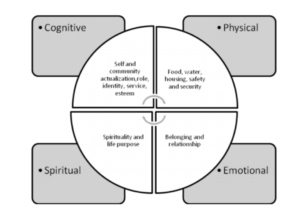
When you reach the top of the tipi, you recognize that you will be forgotten but have had a part in ensuring that “your people’s important teachings live on” (Blackstock, 2011). The bottom line is that the Aboriginal teachings suggest that the self is only the beginning, knowing that community actualization and cultural teachings are above the individual. Only in our Western society is this flipped, prioritizing the individual (Bray, 2019). In the teachings of holisitic wellness in this framework for study, it is important that we acknowledge the importance of community wellness, at varying levels. Social wellness is explained by Tinckler (2017) as it “arises from the idea that well-being in one’s life comes from both a positive sense of self and positive sense of belonging. Expressed another way, I offer that social wellness is experienced when the I is healthy and well, and the I is healthy and well in its interactions with others” (p.323).
See below a comparison of the Blackfoot Nation beliefs, next to Maslow’s beliefs. These teachings will be taken in to consideration when discussing the medicine wheel, and holistic wellness in this unit.
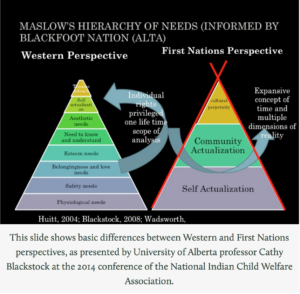
A question for student consideration:
- Why do you think Maslow flipped the tipi when creating his Western version of the hierarchy? Which parts of the tipi do you see as most important?
Design-Thinking:
A large part of this project will be exploration, and will be tied in to other disciplines. Students will be encouraged to reflect on their wellness journeys through explicit activities using Aboriginal teachings and story, other concepts of health and wellness, but also during “regular” activities like mathematics.
During the last term, students will be asked to improve an area of wellness in their lives. This will be done using the design-thinking process. Ideally, students will have had previous experience throughout the year with design-thinking, either from another discipline, or project in the classroom.
This will be a perfect opportunity for students to engage in the design-thinking process in a way that is meaningful and relevant to their health and wellness. Due to the nature of the project, this will be a human-centred approach to design. As mentioned before, there will be emphasis on community wellness along with individual wellness, so the “empathize” stage of the process should come naturally. Students will have already spent time exploring their own needs, strengths, as well as time spent observing and collaborating with others to explore their well-being. According to Plattner (n.d.) “the Empathize mode is the work you do to understand people, within the context of your design challenge. It is your effort to understand the way they do things and why, their physical and emotional needs, how they think about world, and what is meaningful to them” (n.p.). Students will take the time to engage in this process, to come up with a project that is relevant and meaningful, while sharing their learning from the year.
I believe that with proper guidance throughout the term, students will invest in this project. We are always curious about how we feel, why we feel that way but often don’t explore the reasoning behind this. By encouraging students to explore their wellness, they may begin to take ownership over how they feel. Knowing they have some power to improve their well-being allows students to feel confident in this exploration.
A good question is what leads to a good project. By the end of the term, students should be invested in their wellness. This is where the project comes in to play. A “well-designed, open-ended, learner-definable prompt is the best starting place for project based learning” (Martinez & Stager, 2013, p.59). By asking “how can we improve an aspect of wellness?” we are inviting students to complete a project that is meaningful, within their skill and ability level, and allows for them to be creative. It is not a question that has a specific answer, and I think it invites students in to a journey that they will hopefully continue beyond their school years.
Student Reflection & wellness journals:
I have been trying to think of a way to record and capture student learning, as this is a year-long project. As this is an exploration into the meaning of wellness, both individual and community, there needs to be a record of student work not only that is meaningful for assessment, but that also allows students to add their own flair.
After doing some research, I decided a wellness journal would be an excellent way to do this. This wellness journal can be something used to reflect after activities in writing, where photos or activities can be pasted, where students can doodle, sketch or share anything that is relevant to their wellness journey.
Although students may be asked to answer certain questions, or reflect at specific times, this journal is something that is for the student to record their growth. I want it to be something that they can feel connected to, and see their personal growth and understanding as it evolves. Research has shown that by keeping a journal, students may increase their overall sense of happiness, as well as a range of physical, psychological and social benefits such as high levels of positive emotions and increased compassion (The Happy Self, n.d.).
There are lots of sample wellness journals online, and here are a few components that may be included (Collins, 2019; Meredith, 2016).
- Goals
- Classroom activities (ex: photos, worksheets, sticky notes etc.)
- Events- A daily section of quick notes on what happened, and how it affected one’s overall wellbeing.
- Mood Calendar- Daily check-in of mood (may be connected to events).
- Journaling and Reflection
It is important that this is a living journal, and students will take time to reflect on previous entries, noting how they feel now or what has changed. This journal will help students for with the final inquiry project, improving an area of wellness. “Ultimately, the wealth of knowledge contained in your journal will help you get to know what makes you feel awesome, and what makes you feel not so great” (Meredith, 2016, n.p.).
Sample Journal Page for Inspiration:
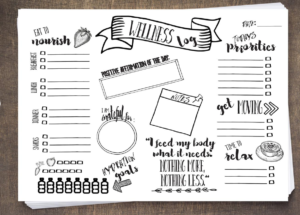

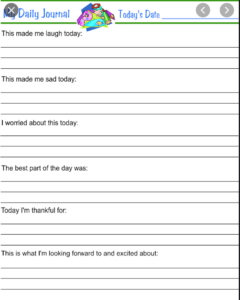
Project Framework (Brainstorm):
Guiding Questions (For Teachers):
- What physical changes can I make to my classroom to support holistic wellness?
- What changes or additions to my routine can I incorporate into my teaching day that will support holistic wellness?
- What language choices and resources will enhance this overarching idea of community building and wellness in my classroom?
- How can I involve Indigenous knowledge in this learning? Who can support and share stories or ideas with my students to foster a connection to the community?
- How can I be inclusive and sensitive to individual backgrounds and experiences while still exploring ideas of wellness?
Ideas (Start small/choose a few if starting from nothing):
- Community building activities
- Weekly wellness challenges
- Mindfulness routines- meditation, yoga etc.
- Physical exercise daily- walks, movement breaks.
- Flexible Seating
- Music
- Breathing exercises
- Storytelling to support community
- Sharing circles
- Programs or activities to support social emotional well-being.
For Students:
*Students will explore self-reflection by keeping a wellness portfolio (formative and summative assessment). As we work through the activities in this year-long exploration, students can keep samples of work, written reflections, photographs, sketches etc. to demonstrate their learning.
Phase 1 (Term 1):
Guiding Questions:
- What is wellness?
- What does it mean to be well?
Students will begin by exploring holistic wellness with an Indigenous lens. This phase will begin using the teachings of the medicine wheel to begin to analyze the different aspects of wellness. We will emphasize the holistic model, exploring how the aspects of wellness are interconnected and have implications for our lives and our community. Ideally, elders or community members would be invited in to explore wellness and share stories with the students at this stage.
Phase 2: (Term 2)
Guiding Questions:
- How do we know when we are well? How do we know when others are well? Our school? Our community? Nature?
- How do we take care of ourselves already? How does our wellness affect others?
Students will continue to explore the aspects of wellness, however take a deeper reflection on their current state of wellness. This phase will involve exploration of our own current practices, sharing with peers and researching less known or used aspects of our wellness. We will begin to take a look at community wellness, starting at the school level and moving forward at looking at community supports that are in place.
Phase 3: (Term 3)
Guiding Questions:
- What are the most important aspects of wellness and holistic health and well-being? Are there aspects of our health that are more important than others?
- What supports are in place for wellness in our personal lives, in our school and greater community? How can we improve these supports, or invent new ones?
In this phase, students will go through the design process to improve or create a new program/physical space/routine that will allow for increased wellness. Students will have the opportunity to do something as small as creating a personal routine, to changing a space in the classroom, to implanting a program at the school level, or as broad as implementing a policy or program at the community level.
Curriculum Connections:
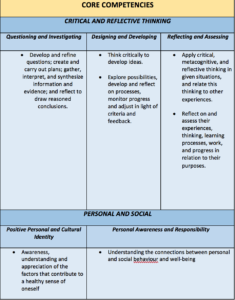
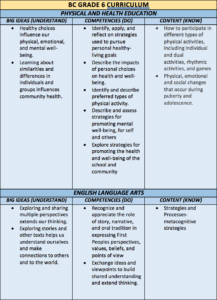
First People’s Principles of Learning:
This inquiry framework involves the teaching of elders, traditional wellness, the medicine wheel, storytelling, reflection, and exploration of one’s identity. The First People’s Principles of Learning naturally occur throughout the year.
Relevant FPPL:
- Learning ultimately supports the well-being of the self, the family, the community, the land, the spirits, and the ancestors.
- Learning is holistic, reflexive, reflective, experiential and relational (focused on connectedness, on reciprocal relationships, and a sense of place).
- Learning recognizes the role of indigenous knowledge.
- Learning is embedded in memory, history and story.
- Learning requires exploration of one’s identity.
(FNESC, First Peoples Principles of Learning, Retrieved 16 July 2020 from http://www.fnesc.ca/wp/wp-content/uploads/2015/09/PUB-LFP-POSTER-Principles-of-Learning-First-Peoples-poster-11×17.pdf)
Inquiry-Based Learning:
This unit is designed to be very flexible, and exploratory. Students are asked to reflect regularly while examining holistic wellness, both individually and at the community level. My hope is that the teacher will guide the students and provide opportunities for students to challenge ideas of wellness, learn from story, and analyze their own well-being. Students will begin to understand and acknowledge the interconnectedness of their well-being and how their choices and environments play a role. I have began to reflect on how the choices made in this project/framework fit within Galileo’s Rubric for Inquiry (Galileo Educational Network, 2020).
Authenticity
This project embeds several curricular competencies, content and big idea across many disciplines. Most importantly, it connects beautifully to the overarching core competencies in the BC Curriculum. The main question: “What is wellness?” is relevant to our local community, but also is a significant question that all humans should take the time to explore. Our well-being is a shared experience, and for that reason it is important.
The activities and exploration include both the individual, the peers, the family and the greater community. They will allow students to explore their own ideas, collaborate with others, and explore different backgrounds and experience with sensitivity and a critical lens.
Academic Rigour
Students will explore story, engage in activities across the disciplines, transfer their knowledge across disciplines, and begin to understand how the questions relate to life outside of school.
Through the keeping of a wellness journal, students are given the opportunity to share their knowledge and learning in their own way.
Assessment Sponsors Deep Learning and Improved Instruction
Ongoing completion of a wellness journal allows for formative assessment and record of student learning. Reflection will occur throughout the year, through a number of activities, routines and frameworks adopted in the classroom.
Adds Value Beyond School
Students will understand how their wellness affects their lives, even outside of school. The final project may involve a community program, or physical structure that will benefit others outside of the classroom. Students are given the opportunity to connect with elders and others in the local community throughout the project.
Students Learn with Digital Technologies
I have not thought about this too much yet. Students will likely photograph their experience to add to their journals, and engage in research using technology.
Students Engage in Active Exploration
Students will reflect constantly on their experience, both individual and shared. Due to this being a year long “project” or routine in the classroom, students will hopefully be thinking about their wellness throughout their school experience. They will be given opportunity to reflect, connect with peers, and explore different questions relating to wellness across the disciplines.
Connecting with Expertise
Students will connect with and participate in shared activities with local members from Aboriginal communities. I would also like to have other local stakeholders come present, or spend time with the students (Ex: mayor, council, business owners, recreation coordinators, nurses, health advocates etc.) so they have a wide variety of knowledge and experience with wellness outside of the school.
Elaborated Forms of Communication
The wellness journal will be an excellent form of communication that will also track student growth. Students will share their final projects with relevant stakeholders (ex: community project shared with community members, school project shared with principal and other classes etc.).
Further Questions:
- Is the scope of the project too broad to be considered inquiry-based learning?
- How can I incorporate specific lessons into this framework without being too prescriptive?
- How can I incorporate Aboriginal teachings and ways of knowing/being while ensuring the resources remain authentic?
- How do I incorporate meaningful assessment opportunities throughout the year when the students work (journals) may be private or sensitive?
- How can I explicitly teach students how to reflect in a way that is meaningful to ensure they are “on track” with their learning?